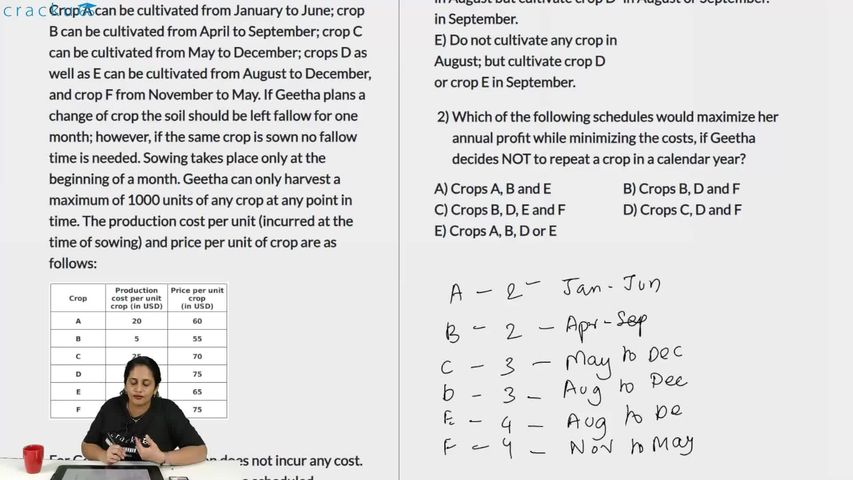Analyse the following caselet and answer the questions that follow:
Geetha Gawde can cultivate up to 6 crops a year. Crop A and B are ready for harvest in 2 months; crop C and D in 3 months, and crop E and F in 4 months. Crop A can be cultivated from January to June; crop B can be cultivated from April to September; crop C can be cultivated from May to December; crops D as well as E can be cultivated from August to December, and crop F from November to May. If Geetha plans a change of crop the soil should be left fallow for one month; however, if the same crop is sown no fallow time is needed. Sowing takes place only at the beginning of a month. Geetha can only harvest a maximum of 1000 units of any crop at any point in time. The production cost per unit (incurred at the time of sowing) and price per unit of crop are as follows:

For Geetha soil preparation does not incur any cost. If a crop is abandoned before the scheduled harvesting, she gets no money. Geetha is preparing a cropping schedule to maximize her annual profits (i.e. price – cost). She plans to replicate the schedule in the coming years.
Which of the following would DEFINITELY be a part of the ideal schedule?
Solution
As per the given conditions the following details have been mentioned .

Now Since for the months of January , February and March we have crop A for use .
So We select crop A for the months of January and February and earns a profit of USD 40000 . (1)
The author wants to replicate the same schedule for the upcoming years.
So If he wants to use Use crop A for the upcoming years in the month of January we must make sure that the month pf December must be left empty because we cannot use crop A in the month of November .
Considering crop A and crop B only they could be used from January to September . A period of 9 months . The reason for considering B is that it requires low time frame and relatively higher profits .
If we plan to use only A and B for the period of 9 months we are left with a period of 3 months and since we cannot sow a crop in the month of December and we are left with October and November .No crop can be completely harvested in the period of 2 months . Hence we must stop using A and B even before the month of September is reached.
While considering a set of crops the choice must be made on the basis of low time period and High Returns .
After February is complete we can extend the crop A once more or twice more which gives us returns of USD 80000 for the period of Jan to April or USD 120000 from Jan to June .
The other case leaves us with taking a gap of 1 month in the month of March and sowing B in April .
If B is sowed in April and May it would provide a return of USD(40000+ 50000) =USD 90000 . (2)
If B is sowed in 2 consecutive sessions of April, May and June, July we earn USD (40000 +100000) = USD 140000 . (3) .
Until the month of August the best choice is sowing A from Jan to Feb , Leaving the land empty for March and sowing crop B from April to July .
After July taking a gap of 1 more month to sow a different crop and make sure the crop is harvested in 3 months since
December cannot be used.
The best choice is to sow crop D which is harvested in three months September , October and November and generate a profit of USD 60000 .
The final result is as follows :

Video Solution

Click on the Email ☝️ to Watch the Video Solution
Create a FREE account and get:
- All Quant Formulas and shortcuts PDF
- 15 XAT previous papers with solutions PDF
- XAT Trial Classes for FREE
